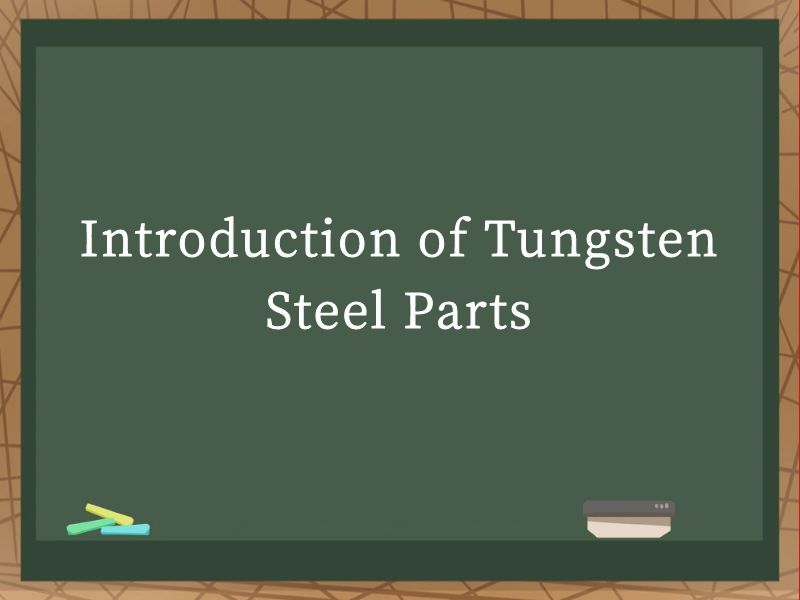JOURNALISM
- NEWS -
|
Introduction of Tungsten Steel PartsIntroduction of Tungsten Steel Parts.Tungsten steel, also known as high-speed steel or tungsten alloy steel, is a versatile material renowned for its exceptional hardness, wear resistance, and heat resistance. Due to these properties, tungsten steel parts find extensive applications across various industries, ranging from automotive and aerospace to tooling and medical equipment. This article delves into the characteristics, production processes, applications, and maintenance considerations of tungsten steel parts, aiming to provide a comprehensive understanding of this remarkable material.
Characteristics of Tungsten Steel Tungsten steel is composed primarily of tungsten, carbon, chromium, vanadium, and cobalt, with tungsten often accounting for up to 18% of its composition. This unique blend of elements gives tungsten steel its exceptional mechanical properties: High Hardness: Tungsten steel parts exhibit hardness levels that surpass most conventional metals. This hardness is crucial in applications where wear and tear are significant concerns. Wear Resistance: The high hardness of tungsten steel translates into excellent wear resistance, ensuring that parts maintain their shape and functionality over extended periods. Heat Resistance: Tungsten steel retains its hardness and strength even at elevated temperatures, making it suitable for high-temperature environments. Good Toughness: Despite its hardness, tungsten steel possesses sufficient toughness to withstand shock loads, which is beneficial in applications involving impact. Corrosion Resistance: The alloy composition of tungsten steel provides moderate resistance to corrosion, further enhancing its durability in harsh environments. Production Processes of Tungsten Steel Parts The production of tungsten steel parts involves several intricate steps, each requiring precision and expertise to ensure the final product meets the desired specifications: Material Preparation: The raw materials, including tungsten carbide powder, cobalt binder, and other alloying elements, are meticulously mixed in specific proportions. The mixture is then milled to achieve a homogeneous blend. Powder Compaction: The blended powder is pressed into the desired shape using various molding techniques, such as isostatic pressing or die casting. This step consolidates the powder particles, forming a green compact. Sintering: The green compact is then subjected to sintering, a high-temperature process that bonds the particles together through diffusion, resulting in a dense and strong tungsten steel part. Sintering temperatures typically range from 1200°C to 1500°C. Heat Treatment: Post-sintering, the parts undergo heat treatment to further enhance their mechanical properties. This includes quenching and tempering processes, which optimize the hardness, toughness, and wear resistance of the material. Machining and Finishing: Once the parts have achieved the desired microstructure, they are machined to precise dimensions and finished to meet the surface quality requirements of the application. This may involve grinding, polishing, or other surface treatment processes. Quality Control: Each step of the production process is subjected to rigorous quality control checks to ensure that the parts meet the specified standards. This includes inspections for dimensional accuracy, material properties, and surface finish. Applications of Tungsten Steel Parts The versatility of tungsten steel parts makes them indispensable in numerous industries, where their unique properties offer significant advantages: Tooling Industry: Tungsten steel is widely used in the production of cutting tools, such as drills, milling cutters, and turning tools. Its high hardness and wear resistance ensure that these tools maintain their sharpness and cutting efficiency over extended periods, reducing downtime and maintenance costs. Automotive Industry: In the automotive industry, tungsten steel parts are employed in components that require high durability and resistance to wear and tear. Examples include gearbox components, engine valves, and brake systems. Aerospace Industry: The aerospace industry relies on tungsten steel for critical components that must withstand extreme temperatures and pressures. Applications include turbine blades, nozzle guides, and other engine parts. Medical Industry: Tungsten steel's corrosion resistance and biocompatibility make it suitable for medical equipment and implants. It is used in surgical instruments, dental drills, and orthopedic implants. Electronics Industry: In the electronics industry, tungsten steel is used in precision components such as drills for PCB manufacturing and machine parts for semiconductor processing equipment. Mining and Construction: The mining and construction sectors utilize tungsten steel for tools and equipment that must endure heavy wear and tear. Examples include drilling bits, mining picks, and excavation tools. Oil and Gas Industry: In the oil and gas industry, tungsten steel parts are found in drilling equipment and downhole tools, where they must withstand high temperatures and pressures while maintaining precision and durability. Maintenance Considerations for Tungsten Steel Parts To ensure the longevity and optimal performance of tungsten steel parts, proper maintenance practices are essential: Regular Inspection: Regular inspections of tungsten steel parts should be conducted to identify and address any signs of wear, cracks, or damage promptly. This preventive approach can help avoid catastrophic failures and extend the lifespan of the parts. Cleaning and Lubrication: Tungsten steel parts should be cleaned regularly to remove debris, dirt, and corrosive residues. Proper lubrication is also crucial to reduce friction and wear, especially in moving parts. Temperature Control: Given tungsten steel's sensitivity to temperature extremes, it is important to maintain operating temperatures within the material's recommended range. Excessive heat can degrade the material's properties, while excessive cold can cause embrittlement. Storage Conditions: Tungsten steel parts should be stored in a dry, cool, and well-ventilated environment to prevent corrosion and degradation. Avoid exposing the parts to humid conditions or corrosive chemicals. Replacement and Upgrades: When tungsten steel parts show signs of excessive wear or damage, they should be replaced promptly to avoid compromising the performance and safety of the equipment. Additionally, considering upgrades or modifications to the parts based on technological advancements can further enhance their performance and reliability. Tungsten steel parts are indispensable in numerous industries due to their exceptional hardness, wear resistance, heat resistance, and good toughness. From tooling and automotive applications to aerospace and medical equipment, tungsten steel's versatility and durability make it a material of choice for critical components. The production of tungsten steel parts involves a series of precision steps, from material preparation to machining and finishing, each requiring expertise and rigorous quality control. Proper maintenance practices, including regular inspections, cleaning, and temperature control, are essential to ensure the longevity and optimal performance of these parts. As technological advancements continue to shape the future of various industries, tungsten steel will undoubtedly play a pivotal role in driving innovation and efficiency. |


